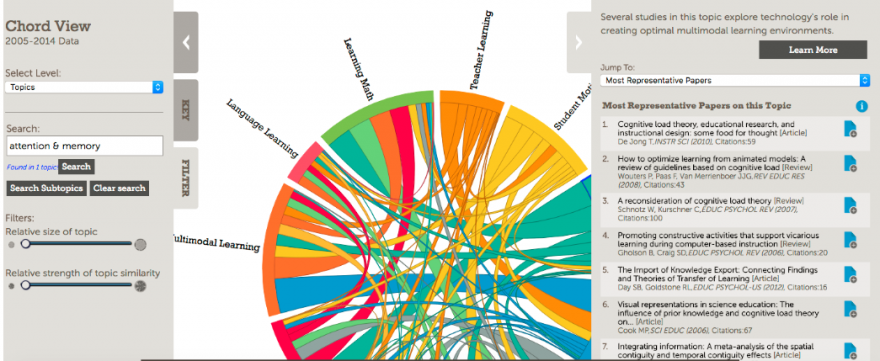New ‘Map’ Connects Ed-Tech Developers, Schools With Academic Research

It’s one of the most basic questions in K-12 education: What does the research say?
Now, a new online tool aims to give both ed-tech developers and school officials a simple way to get an answer. Visitors to the interactive platform can search and filter academic research on areas of interest to schools, from the impact of different classroom strategies to studies focused on specific academic subjects.
Digital Promise, a nonprofit interested in promoting ed-tech and the use of research in schools, says it created the “Research Map” with both companies and schools in mind, so each set of players could probe academic scholarship independently, based on their needs.
The map allows users to search through a database of research drawn from 183 different academic journals, with roughly 6,000 articles. But its reach is even broader, in that it allows users to analyze trends across academic research drawn from about 100,000 articles.
Specifically, Digital Promise says that the map draws from nearly 100,000 articles published between 2005 and 2014 that were found in 183 academic journals in the Web of Science database. The organization looked at features of articles, such as the titles, authors, cited references, and abstracts. Then, it created a “bibliographic coupling network” to link articles with at least two common references.
The tool is meant to act as a “starting point” for ed-tech developers and K-12 officials, said Aubrey Francisco, Digital Promise’s research director. The organization started with the question of “how can we make it easier for educators and product developers to access research?” she said.
For both companies and K-12 educators, the reality is “you don’t know what you don’t know,” Francisco said. “If you don’t know what research is out there, you can’t find it” and use it.
The Research Map allows users to search by term for what academic research says on various topic—from literacy to math to interest area—through two different options, called the “network view” and the “chord view.”
The network view may be more helpful if the user is new to a topic and interested in understanding the body of research on it, Francisco said. The chord view is better for drawing connections between topics—for instance, how research about students’ “attention and memory” is tied to research about learning math. (See an image of one of the searches, above.)
A developer trying to build a reading app, for instance, could use the Digital Promise tool to search and gain an understanding of the importance of phonemic awareness. The database would provide links to research, giving companies information on the most active academic scholars on that topic—and potentially, leads on who to reach out to for help, Francisco said.
A search within the “Network View” on algebra produced a list of research divided into areas that included student motivation, teaching reading, multimodal learning, and other areas. With a click on any of those areas, visitors to the site are given a list of academic studies focused on the topic.
Some articles have been made freely available online. Others are behind paywalls. Digital Promise’s site, however, also gives boiled-down summaries of research on various academic topics, with citations to more detailed scholarship.
Digital Promise designed the tool and has been sharing it and refining it for about a year, Francisco said, showing it to school officials and companies and gathering their input.
How much of an appetite K-12 officials have for sifting through academic research through the site remains to be seen, Francisco acknowledged. (District leaders often rely on word-of-mouth recommendations and other informal sources when choosing products.) But the site is aimed at smoothing their access to high-quality scholarship.
“This is a step in at least making the research easier to access,” she said.
Digital Promise has taken a strong interest in trying to help ed-tech companies and schools better understand each others’ needs.
It has backed studies of shortcomings in how K-12 systems attempt to select and buy products, and how they pilot-test digital tools. Last year, the organization released a tool designed to help school officials judge companies’ claims of having evidence of their products’ effectiveness.
This post has been updated with details about the sources of the academic research.
See also:
